Watching the many tourists visiting my hometown of Washington, DC this week for the Presidential Inauguration and enjoying the wonders of our beautiful neo-classical architecture in our monuments, buildings and museums, I was inspired to write this post on this intriguing new book by Washington, D.C. and architectural historian Pamela Scott entitled Capital Engineers: The U.S. Army Corps of Engineers and the Development of Washington, D.C. 1790-2004.
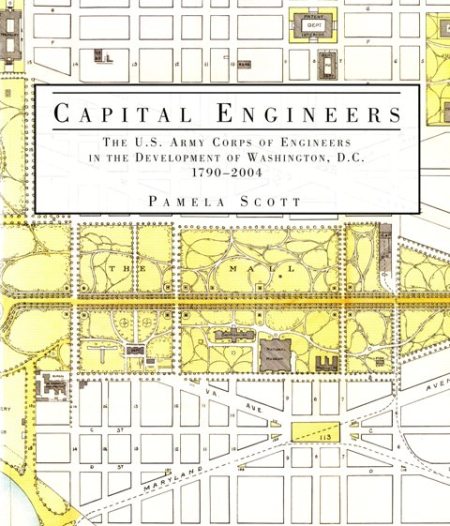 Although best known for its “water resources and environmental work and its construction of facilities on military bases,” the U.S. Army Corps of Engineers played a pivotal role in the design and construction of our Nation’s capital: Washington, D.C. Not only did Army Engineers fill the role of one of three commissioners who ran the city, they were instrumental in constructing a new and rapidly growing city on donated land, including literally creating land out of swampy terrain on the banks of the Potomac River where today National Airport, majestic monuments and sprawling public spaces can be found.
Although best known for its “water resources and environmental work and its construction of facilities on military bases,” the U.S. Army Corps of Engineers played a pivotal role in the design and construction of our Nation’s capital: Washington, D.C. Not only did Army Engineers fill the role of one of three commissioners who ran the city, they were instrumental in constructing a new and rapidly growing city on donated land, including literally creating land out of swampy terrain on the banks of the Potomac River where today National Airport, majestic monuments and sprawling public spaces can be found.
The purpose of this large, beautifully presented book is to bring to the public’s awareness the depth of involvement of the U.S. Army Corps of Engineers in the design, development, construction, and maintenance of our Nation’s capital by effectively chronicling its history and showcasing rare images, maps, and drawings of the Corps’ work. In the preface we learn that many of these images were in poor condition and not accessible to the public before, but the advent of digital photography and scanning has made these available to stunning impact in this high-quality publication.
The book is broken into 6 sections covering periods from 1790 to 2004:
- The Grand Design, 1790-1800. During this period our first President George Washington hires French engineer Peter Charles L’Enfant (who had served with him in the Continental Army) to create a grand vision to lay out the city on the land donated for the purpose from Maryland and Virginia. In addition to creating the original plan for the capital city of this new nation that was reminiscent of Paris, L’Enfant also proposed the founding of the permanent Corps of Engineers to “play a key role in the development of the country’s public as well as military infrastructure.”
- The Antebellum City, 1800-1865, is a period where The Smithsonian Institution is built along with the start of the Capitol, and infrastructure begins to be laid.
- The Victorian City, 1865-1890, marks the building of the Washington Monument and the Library of Congress.
- The Progressive City, 1890-1915 delivers the Government Printing Office, The Lincoln Memorial, Rock Creek Park, and Potomac River bridges.
- The Expanding City, 1915-1950, is the period during two world wars, and noted is the building of the Pentagon among other Federal buildings and growing infrastructure.
- Metropolis, 1950-2004 is the final stage covered, when the city turns into a metropolis, and requires expanded infrastructure to support this.
However, the most fascinating part of the book is the many anecdotes sprinkled throughout, giving the reader a feel for the many strong personalities involved in building the beautiful city we have today and the many controversies that surfaced throughout the over two centuries since its founding.
For example, this year’s Inaugural Committee Chairman Charles Schumer (D-N.Y.) organized the 2013 Inauguration ceremony around a theme commemorating the completion of the Capitol Dome 150 years prior on December 2, 1863, two years ahead of President Lincoln’s second inauguration on March 4, 1865. Said Senator Schumer on Monday as he kicked off the second inauguration of President Barack Obama and Vice President Joseph Biden:
“When Abraham Lincoln took office [in 1861], two years earlier the dome above us was a half-built eyesore… Conventional wisdom was that it should be left unfinished until the war ended, given the travails and financial needs of the times. But to President Lincoln the half finished dome symbolized the half divided nation. Lincoln said, ‘If people see the Capitol going on it is a sign we intend the union shall go on.’ And so, despite the conflict which engulfed the nation, and surrounded the city, the dome continued to rise.”
Image: First Inauguration of Abraham Lincoln, March 4, 1861, beneath the unfinished Capitol dome. Source: Library of Congress
To continue Lincoln’s vision to complete the construction in spite of the Civil War, the Corps continued work on the ambitious and tricky Capitol Dome, with the book showing rare photos and drawings of the work being done, including the planned design and engineering behind this magnificent structure.
Image: Cross-section drawing by Thomas Ustick Walter for the dome of the United States Capitol building, circa, 1859. Source: Library of Congress.
Another story from the book is that General Thomas Lincoln Casey, Chief of Engineers at the time, decided to avoid both extensive congressional debate and public criticism in the building the Library of Congress and “embarked on the Library’s decorative scheme without prior approval of Congress.” Using the time-honored Washington tradition of masking expenditures in generalities, Casey hid the hiring of sculptors under a generic heading of “marble work” and that of fine artists under “painting” in his annual reports. Such was the faith in his work that Congress was not fazed by this deception when it was revealed.
An interesting chapter about the Washington Monument showed the Corps identified a need to shore up the foundation in order to build the obelisk to the necessary height in accordance with ancient Egyptian proportions. Such was the respect for their findings that Congress authorized additional funds for the Corps to build a new cement foundation to provide the long-lasting support desired.
Image: Cement foundation under the Washington Monument in May 1880. Source: Library of Congress
Eventually, the foundation was covered with a beautiful lawn and the entire grounds landscaped by the Corps, to the delight– and relief– of all D.C. residents, expressed by local newspaper columnist George Alfred Townsend:
“The old grounds around the Washington Monument, which the very goats disdained to frequent and truant school-boys passed through with awe… were now brought into civilization… and a sense of gratitude toward the Engineer was felt by every thoughtful visitor.”
Skeptics throughout the history of the city from Washington’s cabinet to Abraham Lincoln’s own administration, did not see the vision of the completed city that the Corps of Engineers could. In fact, shortly before President Lincoln’s First Inaugural on March 4, 1861, aide John Hay ascended to the base of the Capitol’s yet-unconstructed dome and was quoted giving a bleak portrait of the unfinished city, saying:
“Why did they attempt to build a city where no city was ever intended to be reared? It will never be a capital, except only in name; never a metropolis like Rome, or London, or Paris.”
Fortunately, the book shows that Corps of Engineers had a broader vision and optimism, creating a major city with stunning vistas that rival those of major capitals throughout the world. All Americans owe, as Townsend said above, “a sense of gratitude” to the U.S. Army Corps of Engineers for our beautiful capital city!
Image: United States Capitol bedecked in red, white and blue for the Presidential Inauguration this past Monday, January 21, 2013. Note the magnificent dome with the statue of Freedom atop it, and compare it to President Lincoln’s inauguration above. Photo courtesy of MarthaStreet.com
How can I obtain a copy of Capital Engineers: The U.S. Army Corps of Engineers and the Development of Washington, D.C. 1790-2004?
- Buy it online 24/7 at GPO’s Online Bookstore.
- Buy it at GPO’s retail bookstore at 710 North Capitol Street NW, Washington, DC 20401, open Monday–Friday, 9 a.m. to 4 p.m., except Federal holidays, (202) 512-0132.
- Find it in a federal depository library.
About the Author: Michele Bartram is Promotions Manager for GPO’s Publication and Information Sales Division in Washington, DC, and is responsible for online and offline marketing of the US Government Online Bookstore (http://bookstore.gpo.gov) and promoting Federal government content to the public.
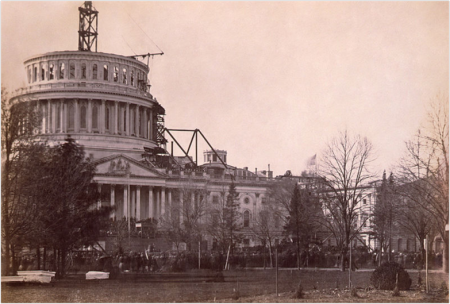
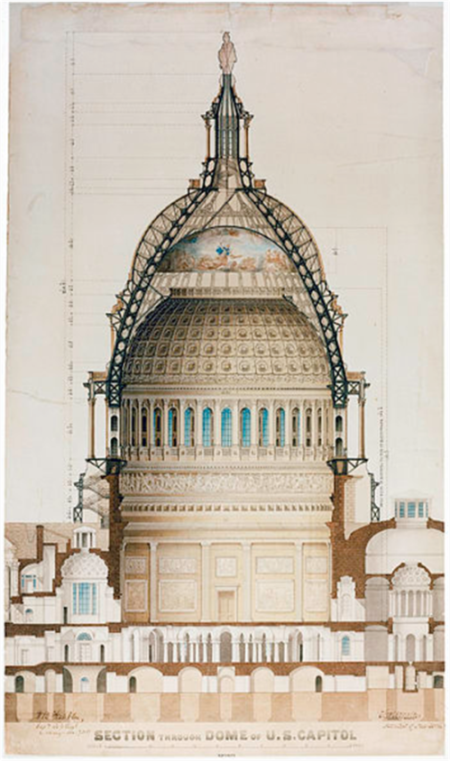
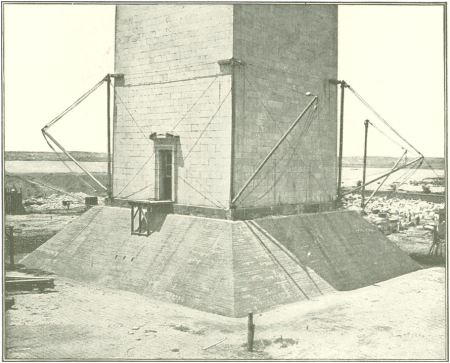
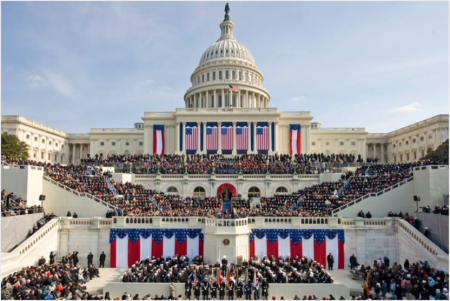

Also available as a free PDF at: http://www.usace.army.mil/About/History/Bookshelf/Books.aspx